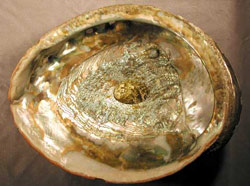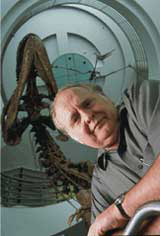UC Berkeley Press Release
Abalones may owe their huge size to otters
BERKELEY – Abalone divers, who typically despise the California sea otter because of its voracious appetite for the largest and tastiest of the shellfish, may actually have otters to thank for the dinner-plate size of the prized delicacy.
Worldwide, abalones tend to be small, in the range of 2 to 4 inches across, according to evolutionary biologist David Lindberg, professor and chair of integrative biology at the University of California, Berkeley, and a former abalone diver himself. Along the California and Pacific Northwest coast, however, abalones have grown much bigger, culminating in the 12-inch diameter red abalone, Haliotis rufescens, avidly sought by divers and once the center of a thriving commercial fishery.
 A 40-mm tropical abalone, Haliotis glabra, is dwarfed inside the shell of the world's biggest, the cold water Pacific species Haliotis rufescens, the prized red abalone. (Photo by David Lindberg) |
A surge in the last century in the sea otter population, however, killed off the commercial abalone industry along the central and southern California coast and made it hard for sport divers to find any abalones, let alone large, 12-inch ones. Many divers, fishermen and even wildlife biologists worry that the otter is driving the abalone to extinction.
A new study of the interaction between abalones and California's coastal kelp forests, however, suggests that the sea otter played a key role in driving up the size of the abalones. Unlike kelp and algae in tropical waters, kelp in cold waters like those along the California coast have not developed toxic chemicals to ward off voracious grazers like sea urchins and snails. As a result, abalones, which live off the drifting, dead kelp so abundant along the Pacific coast, thrive and grow huge on the highly nutritious food.
The researchers speculate that the sea otter helped set up this state of affairs. By ruthlessly preying on sea urchins and smaller snails, otters kept the herbivores at bay, and the kelp had no need to develop chemical deterrents. Abalones could, for the most part, hide from otters in rock crevices while gorging like couch potatoes on the tasty kelp washed up on their doorstep.
 David Lindberg (Fred Mertz photo, courtesy Howard Hughes Medical Institute) |
"We realized with this study that most abalones are small, averaging two inches across, and live on coral reefs in the tropical Indopacific," Lindberg said. "So why does the world's largest abalone live in the same place as this major predator, the sea otter? We think the abundance of kelp, the ability of abalones to stay hidden in crevices and the predation of otters set up an ideal system to ratchet up the size of abalones."
"There is very little doubt that in the old days, before people were part of the system and when otters were abundant along this coast, anywhere abalones occurred, the otters had a very limiting effect on their distribution and abundance," said James Estes, a research scientist and marine ecologist with the U.S. Geological Survey (U.S.G.S.), who works out of UC Santa Cruz's Long Marine Laboratory in Monterey. "I think what was really going on was a dynamic equilibrium, where the populations in the crevices built up and the abalone would be pushed out to the point where otters could get them on the edges of the crevice. There were still lots of them there, but there was still a fair production that was being exploited by sea otters as well."
Estes, Lindberg and Charlie Wray, a former UC Berkeley post-doctoral fellow, published their findings in the current issue of the journal Paleobiology.
Lindberg has always been puzzled by claims that the otters are driving the abalones to extinction, since it is known that sea otters and abalones have shared coastal waters for the past 5 million years. The newcomers to the area, he said, are humans. Middens or refuse piles along the coast show that, historically, the California Indians also loved abalone and were the first to deplete the abalone population along segments of the coast.
"Since we can demonstrate that the large size increase took place in the presence of otters, the only hypothesis left as to the cause of the demise of a lot of abalone stock is human overfishing and probably destruction by humans of habitat," Lindberg said. "Getting an evolutionary grasp on a system gives us power in understanding its ecology and physiology, even if you are talking about management of wildlife stocks."
Colleagues for more than 20 years, Lindberg and Estes had often talked about the interactions along the coast between sea otters, abalones and the abalone's principal food, kelp. Lindberg, a malacologist and former director of UC Berkeley's Museum of Paleontology, specializes in the evolution of mollusks. Estes, who has studied otters for some 35 years, has had a long-standing interest in the history of the kelp forests off the California coast. The two teamed up with Wray, a molecular geneticist, to look at the evolution of abalone size and how abalones may have affected the evolution of kelp.
Estes earlier had suggested that, as the Earth began to cool 45 million years ago, kelp moved out of their tropical homes into cooler waters in temperate regions of the northern and southern hemispheres. The first radiation was into southern oceans 42 million years ago as the Antarctic ice sheet developed, followed much later, perhaps 10 million years ago, by radiation into the northern oceans as the Arctic froze over.
The current study, in which Wray used DNA comparisons to determine the family tree of the abalones, supports these dates. The abalones, which originated about the time the dinosaurs died out 65 million years ago, moved into the same temperate areas around the same time as the kelp. Perhaps because the kelp left behind many of the grazers that keep tropical kelp and macroalgae down, the temperate, cold-water kelp never developed the toxic chemicals that are typical of tropical kelp, and abalones were able to grow large on the abundant food.
"In tropical systems, abalones are little bitty things. But wherever one looks around the world where there are kelp forest systems in cold oceans, that's where the bigger abalones occur," said Estes. "One of our major conclusions is that this has happened relatively recently in evolutionary time, starting around 5 million years ago."
Of eight abalone species now living along the Pacific coast from Baja California to British Columbia, six - the red, black, pink, white, green and flat - are all 7 inches across or larger. Several species off the Japanese coast and in Antarctic waters also are significantly bigger than tropical species, which have remained small.
Interestingly, tropical kelp and algae have developed such toxic tissues that abalones no longer feed on them, but instead have turned nocturnal and feed on blue green algae and diatoms that form a scum on reef surfaces. Over time, kelp from the north has even returned to southern waters, yet abalones still avoid it as if it contained the same toxins as the original tropical kelp.
To both Lindberg and Estes, though, the California sea otter stood out as an intriguing member of the kelp/abalone community. Fossil evidence shows that otters have long lived along the coast and eaten the biggest and best of the abalone. Otters today take stones and pound on the underwater abalones until the shell margins break, then pry the abalones off the rocks with their paws. Or, they cave in the shells with a rock and come back later to peel the weakened abalones off the rocks. While in some situations, predators can drive prey to become larger to better fight off attacks, in the case of abalones, getting bigger just made them more attractive as a food source.
"If size is not a refuge, why would you get big, especially where you have a convenient predator taking you out at the same time?" Lindberg asked.
Hence the researchers' speculation that abalones grew large, in part, because of otters. The system lost its balance in the 1700s, when Russians first began slaughtering otters and fur seal for their pelts. By the time otter and seal harvesting was outlawed in the early 1900s, the otter was thought to be extinct. Abalone populations rose, and abalones moved into more open spots, even developing a more peaked shell since they no longer needed a slim shell to hide in crevices.
"We got a taste for abalone in the absence of otters, and now that the otter has come back, we're blaming the otter as a threat to the abalone," Lindberg said.
A remnant population of otters off Big Sur eventually grew to populate the entire central California coast, though it has yet to move south in numbers to the Channel Islands, or north beyond San Francisco. Divers fear that the California abalone sport fishery is doomed if otters do move towards the Mendocino coast.
"If otters spread into northern California, which is entirely a sport fishery now, a recreational fishery, a free diving activity - you can't exploit them using scuba, just breath-hold free diving - it will be pretty much over," Estes said.
The good news is that sharks may be keeping them from spreading that far north, Estes said. He noted, too, that killer whales seem to have decimated otter populations along Alaska's Aleutian chain.
Lindberg said that the abalone/otter conflict is one of several unforeseen consequences of the Marine Mammal Protection Act, which was signed in 1972 and has led to a rapid rise in sea mammal populations off the California coast. Seabird nesting areas are being impacted by a burgeoning sea elephant population, while sharks drawn by the mammals increasingly are attacking humans.
"We make management decisions all the time without an evolutionary perspective on how the system assembled over time," Lindberg said. "An evolutionary perspective is critical for understanding ecological context."
The work was funded in part by the National Science Foundation and the U.S.G.S.

